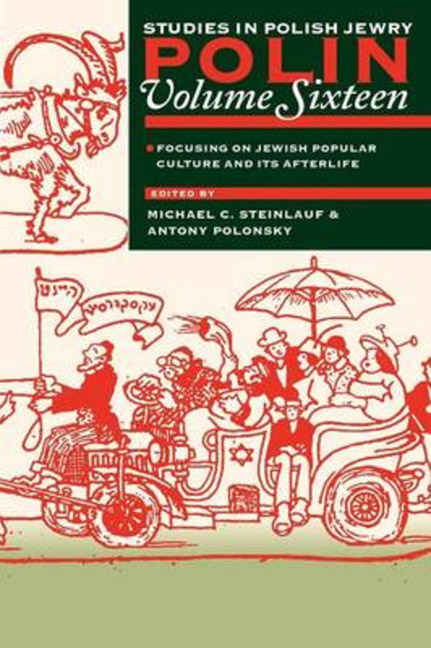Book contents
- Frontmatter
- Dedication
- Editors and Advisers
- Preface
- Polin
- Polin: Studies in Polish Jewry
- Contents
- Note on Place Names
- Note on Transliteration
- PART I JEWISH POPULAR CULTURE IN POLAND AND ITS AFTERLIFE
- Introduction
- IN PRE-WAR POLAND
- AFTERLIFE
- PART II DOCUMENTS
- PART III NEW VIEWS
- PART IV REVIEWS
- REVIEW ESSAYS
- BOOK REVIEWS
- CORRESPONDENCE
- OBITUARIES
- Notes on the Contributors
- Glossary
- Index
Introduction
from PART I - JEWISH POPULAR CULTURE IN POLAND AND ITS AFTERLIFE
- Frontmatter
- Dedication
- Editors and Advisers
- Preface
- Polin
- Polin: Studies in Polish Jewry
- Contents
- Note on Place Names
- Note on Transliteration
- PART I JEWISH POPULAR CULTURE IN POLAND AND ITS AFTERLIFE
- Introduction
- IN PRE-WAR POLAND
- AFTERLIFE
- PART II DOCUMENTS
- PART III NEW VIEWS
- PART IV REVIEWS
- REVIEW ESSAYS
- BOOK REVIEWS
- CORRESPONDENCE
- OBITUARIES
- Notes on the Contributors
- Glossary
- Index
Summary
FROM about the middle of the nineteenth century Jewish life in the Polish lands began to undergo an extraordinary transformation that accelerated during the latter part of the century and the first decades of the twentieth. Our journal has examined many aspects of the Jewish engagement with modernity: the creation of new Jewish demographic centres in the largest Polish cities; the development of Jewish political parties and ideologies; changes in Jewish religious life; the multifaceted relations, in the realms of politics, culture, and society, between Jews and their co-territorial neighbours.
This issue of Polin is devoted to another aspect of this transformation, one that has hitherto received little attention in our journal, or, indeed, anywhere else. The Jewish engagement with modernity in the Polish lands brought masses of Jews out of their small-town communities and conceptions and into the tumult of urban life. A Jewish mass culture resulted that shaped Jewish life in Poland until its end. This culture was constructed above all around the possibilities of Yiddish, the vernacular language of Polish Jews. But the culture far transcended literature and included a diverse array of phenomena including mass-circulation newspapers and magazines, music, theatre, and material artefacts of various kinds. For several generations of Polish Jews, this culture defined the texture of everyday life.
These were Jews who lived in two worlds. On one hand, they could take for granted Jewish law and custom, folklore and legend, as these had developed for centuries in the Polish lands. Regardless of their degree of practice or even belief, they were intimately acquainted with this cultural storehouse; its contents were still instantly recognizable and—more or less ambiguously—still attractive. On the other hand, these were also Jews accustomed to trains, telegraphs, newspapers, and later radios, telephones, automobiles, ballot boxes, and public schools. By the inter-war period they were citizens of Poland; many felt themselves to be citizens of the world as well. They expected an equal share of the rights and comforts of modern societies.
Yet the popular culture these Polish Jews created to serve their daily needs is largely unknown. This is a consequence, first of all, of a well-known bias at the origin of modern Jewish scholarship.
- Type
- Chapter
- Information
- Publisher: Liverpool University PressPrint publication year: 2003

